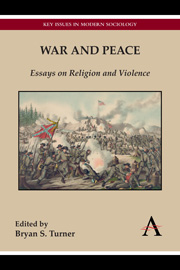Book contents
- Frontmatter
- Contents
- Acknowledgments
- Contributors
- Introduction by Bryan S. Turner
- War
- Peace
- Chapter 5 Quakers, the Origins of the Peace Testimony and Resistance to War Taxes
- Chapter 6 A Sacred Ground for Peace: Violence, Tourism and Sanctification in Hiroshima 1960—1970
- Chapter 7 The Sectarian as a Category of Secular Power: Sectarian Tensions and Judicial Authority in Lebanon
- Chapter 8 The Commodification of Love: Gandhi, King and 1960s Counterculture
- Chapter 9 The Religion of Brotherly Love: Leo Tolstoy and Max Weber
Chapter 10 - Conclusion: War and Peace
from Peace
Published online by Cambridge University Press: 05 May 2013
- Frontmatter
- Contents
- Acknowledgments
- Contributors
- Introduction by Bryan S. Turner
- War
- Peace
- Chapter 5 Quakers, the Origins of the Peace Testimony and Resistance to War Taxes
- Chapter 6 A Sacred Ground for Peace: Violence, Tourism and Sanctification in Hiroshima 1960—1970
- Chapter 7 The Sectarian as a Category of Secular Power: Sectarian Tensions and Judicial Authority in Lebanon
- Chapter 8 The Commodification of Love: Gandhi, King and 1960s Counterculture
- Chapter 9 The Religion of Brotherly Love: Leo Tolstoy and Max Weber
Summary
Introduction
Leo Tolstoy, a veteran of the Crimean War, wrote War and Peace as a serialized novel in the journal Russian Messenger between 1865 and 1867. Published in its entirety in 1869, the novel records the traumatic effects on a number of aristocratic families of Napoleon's invasion of Russia in 1812 and the eventual occupation and burning of Moscow. Like any great novel, it can be read from a variety of perspectives, but at least two major themes stand out. Firstly there is the futility of war and its destructive consequences on the lives of the rich and the poor alike. Secondly there is Pierre Bezukhov's search for a satisfactory meaning for life via debauchery, married life, the Masonic League, and public service. Nothing satisfies Pierre until he finds comfort and eventually meaning in the simple lives of peasants and in the ordinariness of everyday life. Only after suffering and deprivation can he realize that life itself is the paradoxical meaning of life. The novel intertwines the destructive nature of pride and ambition with the peaceful reassurance that comes from engagement with life on its own terms. It has remained a compelling and damning statement about the horrors of war and an inspiration for radical pacifism throughout the twentieth century. It offers a suitable framework for the various chapters in this book which has explored both war and peace as companions of the religions of the world.
- Type
- Chapter
- Information
- War and PeaceEssays on Religion and Violence, pp. 205 - 217Publisher: Anthem PressPrint publication year: 2013



